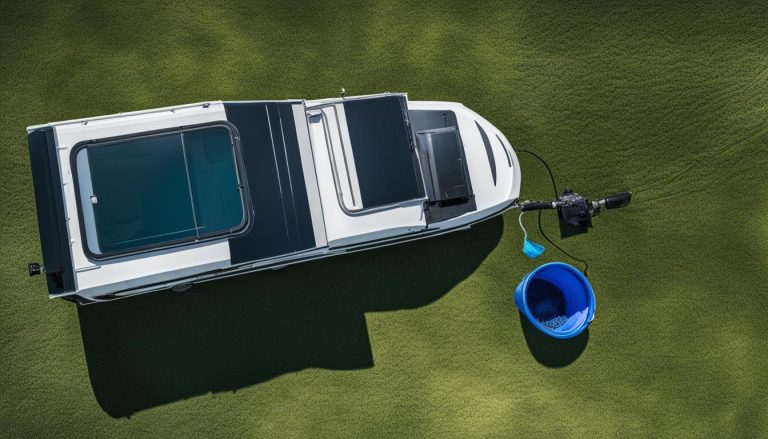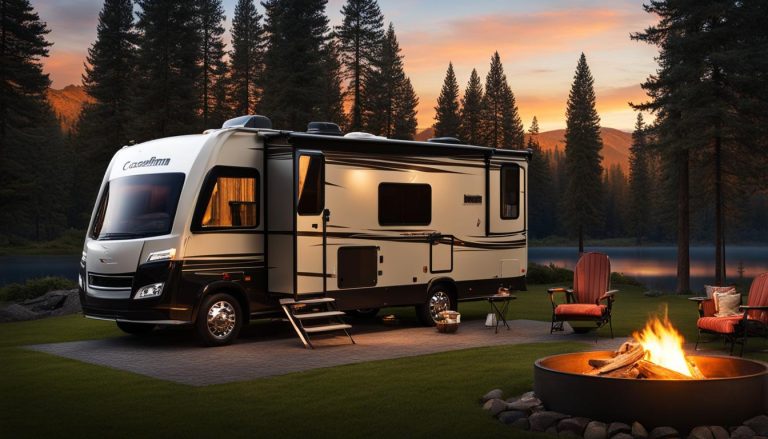RV Life Hacks: Get Hot Water Quickly & Easily
gorvlifestyle.com and its partners may earn a commission if you purchase a product through one of our links
Many RV owners struggle with getting hot water while on the road. Whether it’s running out quickly or not heating up at all, having a consistent supply of hot water is essential for a comfortable RV lifestyle. In this article, we will explore various hacks and solutions to ensure that you can get hot water quickly and easily in your RV. From troubleshooting common issues to optimizing your RV’s hot water system, we’ve got you covered.
- Learn how to troubleshoot common hot water issues in your RV.
- Optimize your RV’s hot water system for better performance.
- Discover solutions to enhance hot water temperature and flow in your RV.
- Get practical tips for quick and efficient showers in your RV.
- Maintain your RV’s hot water system for long-term reliability.
Common Hot Water Issues in RVs
Before delving into the solutions, it’s important to understand the common hot water issues that RV owners face. These can include running out of hot water too quickly, not getting any hot water at all, or experiencing inconsistent water temperature.
In order to address these issues, it is crucial to troubleshoot the problem correctly. Let’s take a look at each of these common hot water problems and provide step-by-step troubleshooting tips to help you identify and resolve the issue. By understanding the root cause, you’ll be better equipped to enjoy a consistent supply of hot water during your RV adventures.
Running Out of Hot Water Too Quickly
One of the most frustrating hot water issues in an RV is running out of hot water too quickly. This can happen if your RV’s hot water tank is too small to accommodate the water needs of your family or if there is a buildup of sediment in the tank that restricts the available hot water.
To troubleshoot this issue:
- Check the size of your hot water tank. If it is too small, you may need to consider upgrading to a larger tank or installing a tankless water heater for unlimited hot water.
- Flush the hot water tank regularly to remove any sediment buildup. Refer to your RV’s user manual for specific instructions on how to flush your hot water tank.
No Hot Water at All
Another common problem is not getting any hot water at all. This can be frustrating, especially when you’re in need of a hot shower or doing dishes. There are several potential causes for this issue.
To troubleshoot this issue:
- Check if the pilot light on your RV’s hot water heater is lit. If it’s not, follow the manufacturer’s instructions to relight it.
- Ensure that the bypass valve, if your RV has one, is in the correct position for using the hot water system. Refer to your RV’s user manual for guidance.
- Inspect the water lines and connections for any leaks or blockages that may be preventing hot water from flowing properly. Tighten any loose connections and clear any obstructions.
Inconsistent Water Temperature
Experiencing inconsistent water temperature can be uncomfortable and inconvenient. It’s important to identify the underlying cause to maintain a comfortable water temperature throughout your RV.
To troubleshoot this issue:
- Check the temperature settings on your RV’s hot water heater. Adjust the settings as needed to achieve the desired water temperature.
- Inspect the mixing valve, if your RV has one, to ensure it is functioning properly. Replace any faulty valves to maintain consistent water temperature.
- Consider adding insulation to your hot water lines to prevent heat loss and maintain a stable water temperature.
By addressing these common hot water issues and following the troubleshooting tips, you can ensure a steady supply of hot water in your RV. Stay tuned for the next section, where we will explore ways to optimize and enhance your RV’s hot water system to maximize your hot water experience.
Optimizing Your RV’s Hot Water System
To ensure a steady supply of hot water in your RV, it’s important to optimize your hot water system. This includes maintaining and servicing your RV’s hot water heater and tank, as well as considering upgrades or modifications to improve efficiency. Here are some tips for optimizing your RV’s hot water system:
1. Regular Maintenance
Regular maintenance is crucial for keeping your RV’s hot water system in good working condition. Here are a few maintenance tasks you should prioritize:
- Flush the hot water tank periodically to remove sediment and mineral buildup that can affect performance.
- Check for leaks or corroded elements and replace them if necessary.
- Inspect the temperature and pressure relief valve to ensure it’s functioning correctly.
2. Insulation
Proper insulation can help retain heat within your RV’s hot water system and prevent energy loss. Consider insulating the hot water pipes and tank to minimize heat dissipation. This will help maintain hot water temperatures for longer periods.
3. Upgrades and Modifications
If you’re looking to improve the efficiency of your RV’s hot water system, consider the following upgrades and modifications:
- Install a high-efficiency RV hot water heater or consider upgrading to a tankless water heater for instant hot water on demand.
- Upgrade to a larger capacity hot water tank to ensure an ample supply of hot water.
- Add a recirculating pump to your hot water system to minimize wait times for hot water at the tap or shower.
By optimizing your RV’s hot water system and following these maintenance tips, you can enjoy a reliable and efficient supply of hot water during your travels. Remember to schedule regular inspections and service to address any potential issues before they become major problems.
| Common RV Hot Water System Upgrades | Pros | Cons |
|---|---|---|
| Tankless Water Heater | – Provides instant hot water – Saves space – Energy-efficient |
– Requires professional installation – Higher upfront cost |
| Larger Capacity Water Tank | – More hot water available – Suitable for larger families or extended stays |
– May require additional space – Increased weight |
| Recirculating Pump | – Minimizes wait times for hot water – Improves water efficiency |
– Requires professional installation – Increased energy consumption |
Enhancing Hot Water Temperature and Flow
If you’re looking to enhance the hot water temperature and flow in your RV, there are several solutions available. Here, we’ll discuss various options that can help you achieve your desired hot water temperature and flow, ensuring a comfortable and convenient experience during your travels.
Installing a Tankless Water Heater
If your current RV water heater is not providing sufficient hot water or struggling to maintain a consistent temperature, consider installing a tankless water heater. Unlike traditional water heaters that store and heat a limited amount of water, tankless water heaters heat the water on-demand as it flows through the system.
By eliminating the need for a storage tank, tankless water heaters can provide an endless supply of hot water, ensuring you never run out during your showers or other activities. They are more energy-efficient and take up less space compared to traditional water heaters. It’s important to choose the right size and model to suit your RV’s needs.
It’s always recommended to consult a professional for installation or seek guidance from experienced RV enthusiasts to ensure a safe and efficient setup.
Using a Booster Pump
If you’re experiencing low water pressure in your RV, which can affect hot water flow, consider using a booster pump. A booster pump increases water pressure, allowing for better distribution and improved hot water flow throughout your RV’s plumbing system.
Booster pumps are particularly useful if you frequently camp in areas with low water pressure, such as remote campsites or older RV parks. Installing a booster pump can significantly enhance the performance of your RV’s hot water system, ensuring a steady and satisfying flow of hot water.
Adding Insulation to Your Hot Water Lines
Insulating your RV’s hot water lines can help minimize heat loss and maintain higher water temperatures. By adding insulation to the pipes, you can reduce the energy required to heat the water, resulting in faster and more efficient hot water delivery.
There are various insulation options available, including foam pipe insulation or heat tape, which are easy to install and can significantly improve the performance of your hot water system. Insulating both the hot water lines and the hot water tank can help to retain heat and maximize hot water temperature and flow.
Remember to regularly inspect and maintain the insulation, checking for any signs of damage or wear that may compromise its effectiveness.

By implementing these solutions, you can enhance the hot water temperature and flow in your RV, ensuring a comfortable and enjoyable experience wherever you go. Remember to consider your specific RV’s needs and consult professionals or experienced RV enthusiasts when needed to ensure a safe and optimal setup.
Tips for Quick and Efficient Showers
Taking quick and efficient showers in an RV can help conserve hot water and ensure that everyone gets a turn without running out. Here are some practical tips to minimize water usage and maximize your hot water supply:
- Turn off the water while soaping up and shampooing. This simple step can save a significant amount of water and allow you to lather up without wasting hot water.
- Invest in low-flow showerheads. These showerheads are designed to use less water while maintaining a strong, satisfying spray. By installing them in your RV, you can extend your hot water supply and enjoy comfortable showers.
- Consider using a shower timer or hourglass. Setting a time limit for your showers can help you stay mindful of water usage and prevent excessive hot water consumption.
By implementing these tips, you can make the most of your RV’s hot water resources, ensuring that everyone onboard can enjoy refreshing and comfortable showers without worrying about running out of hot water.
Final Thoughts and Maintenance Tips
Now that you’ve learned various hacks and solutions to get hot water quickly and easily in your RV, it’s important to prioritize maintenance to ensure a reliable hot water system. By following a few simple maintenance tasks, you can avoid unexpected breakdowns and enjoy a hassle-free hot water experience during your travels.
Regularly flushing the hot water tank is essential to remove sediment buildup and maintain optimal performance. This can be done by following the manufacturer’s instructions or consulting a professional if needed. Additionally, inspect your hot water system for any leaks or corroded elements that may impact its efficiency. Addressing these issues promptly can prevent further damage and extend the lifespan of your system.
Another crucial aspect of hot water maintenance is ensuring proper insulation. By insulating your hot water lines, you can prevent heat loss and minimize energy wastage. This simple step can significantly improve the efficiency of your RV’s hot water system, allowing you to enjoy longer showers and conserve resources.
Remember, proactive maintenance is key to keeping your RV’s hot water system in top shape. By incorporating these maintenance tips into your routine, you can enjoy years of trouble-free hot water in your RV and make the most of your adventures on the road.
FAQ
How can I troubleshoot common hot water issues in my RV?
There are a few steps you can take to troubleshoot common hot water issues in your RV. First, check the power source to ensure your hot water system is receiving electricity or propane. If the power source is functioning properly, check the circuit breakers and fuses. You should also inspect the water heater’s pressure relief valve and drain the tank to remove any sediment or debris. If these steps don’t solve the problem, it’s recommended to consult a professional.
How can I optimize my RV’s hot water system?
To optimize your RV’s hot water system, start by regularly maintaining and servicing your hot water heater and tank. This includes flushing the tank, checking for leaks, and replacing any corroded elements. Additionally, consider installing insulation on the hot water lines to prevent heat loss. Upgrading to a tankless water heater or adding a booster pump can also improve efficiency. It’s important to consult your RV’s manufacturer or a professional for specific recommendations.
What are some solutions to enhance hot water temperature and flow in my RV?
There are several solutions to enhance hot water temperature and flow in your RV. One option is to install a tankless water heater, which provides on-demand hot water and eliminates the need for a storage tank. Another option is to use a booster pump to increase water pressure. Adding insulation to your hot water lines can help retain heat and improve temperature consistency. Consult with a professional to determine which solution is best suited for your RV.
How can I take quick and efficient showers in my RV?
Taking quick and efficient showers in your RV can help conserve hot water and ensure everyone gets a turn without running out. Some tips include turning off the water while soaping up and shampooing, using low-flow showerheads to reduce water usage, and taking navy showers (wetting yourself, turning off the water to lather up, and then rinsing quickly). Additionally, maintaining a comfortable shower temperature can help conserve hot water.
What maintenance tips should I follow to keep my RV’s hot water system in top shape?
To keep your RV’s hot water system in top shape, there are a few maintenance tasks you should regularly perform. These include flushing the hot water tank to remove sediment, checking for leaks or corroded elements, ensuring proper insulation on the hot water lines, and inspecting the pressure relief valve. It’s recommended to consult your RV’s manufacturer or a professional for specific maintenance guidelines based on your RV’s make and model.






